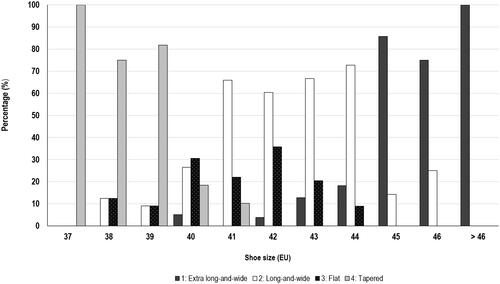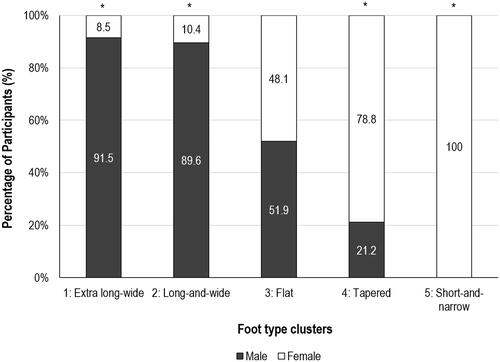Abstract
We must better understand the foot type classifications of netball players to develop sex and size-specific shoe lasts. Five hundred and two representative-level netball players (n = 251 male; n = 251 female) had their feet three-dimensionally scanned. A validated MATLAB code was used to extract six different foot measurements from these scans automatically. We then used a two-step cluster analysis and chi-squared tests to classify foot types and determine the effect of sex on each cluster, respectively. Five foot types were identified (Extra long-and-wide, Long-and-wide, Flat, Tapered and Short-and-narrow), with sex significantly affecting foot type classification. The feet of players wearing smaller shoe sizes were often Short-and-narrow and Tapered, whereas the feet of players wearing larger sizes tended to be more Extra long-and-wide and Long-and-wide. These results highlight that netball players have a wide variety of foot types; manufacturers should use these data to develop future grading systems to improve the fit and functionality of netball-specific footwear.
PRACTITIONER SUMMARY
This study aimed to investigate the foot types of netball players. The results demonstrated that five main foot types should be used to inform future shoe last designs and size grading systems. These findings have implications for improving the fit and functionality of netball shoes, particularly for men.
1. Introduction
Footwear has become increasingly specialised and complex to improve the performance and comfort of athletes (Luximon and Luximon Citation2013). Hence, it is not surprising that footwear manufacturers release a wide variety of uniquely designed athletic shoes for sports, such as netball, every season. Netball is a court-based sport which involves high-impact movements, interspersed with short periods of lower-intensity activity (Fox et al. Citation2013). A netball team consists of seven players, each with an individual playing position, with the aim of the game to score the most goals within a set timeframe (Netball Australia Citation2023). Although females predominantly play netball, many males now participate in the sport (World Netball Citation2021). Because netball has traditionally been female-centric, there has been a proliferation of constantly evolving female netball-specific shoes. Despite the recent growth in men’s netball, little to no attention has been directed towards developing a netball-specific shoe suitable for male players. In fact, only one netball-specific shoe model is commercially available and designed explicitly for men, and this shoe was based on a woman’s last (Personal communications, Mark Doherty; ASICS Oceania Pty Ltd, June 2019). Given the limited choice of netball-specific shoes for men, male netball players are forced to wear a shoe that is not explicitly designed for the sport or tolerate the design and fit of female netball-specific footwear (Kirk et al. Citation2022). As a result, there is a large proportion (82%) of male netball players who report foot-related problems such as blisters, ankle sprains and bruised toenails and dissatisfaction with the width fit and length of their current footwear for netball (Kirk et al. Citation2022, Citation2023a). However, recent research has revealed significant differences in the shape and size of the feet of male and female netball players (Kirk et al. Citation2023b). Specifically, the feet of male netball players are significantly longer and broader than female netball players, notably at the ball of the foot, heel and instep (Kirk et al. Citation2023b). Given these sex differences in foot dimensions, netball-specific shoes designed for women are unlikely to fit the feet of male netball players.
To ensure footwear fits and functions properly, shoes must be based on the foot dimensions of the athletes likely to wear them (Wunderlich and Cavanagh Citation2001). A shoe that functions correctly will ensure it can fulfil its intended purpose i.e., the shoe can provide support and protection on the court whilst also ensuring the athlete can perform unrestricted and pain-free (Kirk et al. Citation2023a). Shoe shape and style largely depend on a shoe last, a three-dimensional mould that approximates the shape of the human foot, around which the upper of the shoe is shaped (Cheskin Citation1987). Traditionally, a model maker usually develops a shoe last based on foot width, girth and length measurements (Adrian Citation1991). However, modern three-dimensional computer-aided design systems have more recently been used to develop last designs (Joneja and Sai Kit Citation2013). The model shoe last is then graded to make shoe lasts of different sizes to fit a selected population (ISO 9407, 1991). The grading of footwear governs how a last progresses from size to size. Although the rules governing how a shoe last is graded typically differ between last manufacturers and shoe brands (Krauss et al. Citation2010), knowledge of foot anthropometrics is essential to optimising the design of a last.
Previous research has demonstrated that a variety of foot shapes exist for a given foot length (Krauss et al. Citation2008). Therefore, different shoe lasts should be used to accommodate variations in foot morphology. Based on a cluster analysis of three-dimensional scans obtained from the feet of 398 men and 397 women, Krauss et al. (Citation2008) reported that irrespective of sex, shorter feet tended to be more voluminous, and longer feet were narrower and flatter. The researchers concluded that different foot shapes require unique shoe lasts for a given shoe size. Furthermore, Jung et al. (Citation2001) divided foot shape into the categories ‘slender’, ‘standard’ and ‘broad’ based on the ratio of foot length to foot width within a sample of 252 Korean elderly men and women. Mauch et al. (Citation2008) cautioned that mean foot dimension values were unsuitable for achieving proper shoe fit because mean values did not adequately represent interindividual differences in foot shape within the same shoe size. Therefore, foot measurements should be derived for each sex and size separately using a foot type classification to develop shoe design recommendations for a given sport (Krauss et al. Citation2008, Citation2011).
Given the sex differences in the foot dimensions of netball players and the lack of netball-specific footwear for men, we need exploratory research to understand better the foot types of netball players, especially men, to inform recommendations for last design and size grading systems. Therefore, this study aimed to: (i) identify whether netball players’ feet can be classified into different foot-type categories and what these categories were, and (ii) determine whether there were any significant differences in foot-type classifications between male and female netball players. We hypothesised that the participants would display a range of foot characteristics, which we could classify into foot-type categories and that these categories would significantly differ between male and female netball players.
2. Materials and methods
2.1. Participants
For this study we recruited 502 (female: n = 251; male: n = 251) netball players, aged 16 years and over, who had participated in at least one season of representative netball in the last 12 months (see ). Participants with any current foot injuries were excluded. Representative netball players were directly recruited from netball training sessions and competitions within Australia, including the Men’s and Mixed Netball National Championships, Netball NSW Premier League and Senior State Titles and Suncorp Super Netball. Participant recruitment was achieved by directly approaching netball players before or after their netball training sessions and competitions and using advertising posters in netball venues. Although the men and women were not matched for height, weight and age, we matched participants for competition level, whereby 85% competed at a sub-elite (regional or state) level, and 15% competed at an elite (national or international) level. The University of Wollongong Ethics Committee approved the study (HREC 2019/326), and all participants provided written informed consent before testing.
Table 1. Mean and standard deviations of the characteristics of the male and female netball players involved in the study.
2.2. Experimental protocol
During the testing session, each participant undertook a single 10-minute experimental protocol at their respective netball training or competition setting. All mandatory laboratory health and safety procedures were followed when conducting the testing procedures. Participants were given a Participant Information Sheet outlining details of the study. They then completed a Participant Characteristics Questionnaire with questions about their age, sex, level of netball competition, footwear habits and any exercise undertaken before the testing session. Three measurements of height (cm) and body mass (kg) were taken using a portable stadiometer (Model: 214, Sea Corp., Maryland, USA) and a calibrated Body Composition Analyser (Model: TISC24oMA, Tanita, Illinois, USA), respectively, following International Standards for Anthropometric Assessment guidelines (Marfell-Jones et al. Citation2012). The average values were recorded and used to characterise the cohort. At least one three-dimensional scan of each participant’s left and right barefoot was taken using a Tiger Full foot three-dimensional scanner (RS scan International NV, Paal, Belgium). A validated MATLAB code (Mathworks®, Natick, MA, USA) was then used to extract six measurements – foot length, medial ball length, foot width, heel width, instep height and first toe height. To verify the validity and reliability of the MATLAB code, we calculated the six measurements for a subset of scans (n = 6) using the code and generated renderings. The extracted values were then compared to the measurements manually taken from participants’ feet by the primary investigator [MMK] using an anthropometer and measuring tape. The code was shown to be valid after conducting a series of paired t-tests, which indicated there were no significant differences between the measurements extracted from the code and the manual measurements, with the p-values ranging from 0.08-0.470 for all six measurements. Six measurements derived from one scan of each participant’s right foot were then used for the analysis after we found intra-measurement reliability to be high for all variables using a two-way random model (ICC = 0.98-0.99). Full details of the scanning procedures and data analysis can be found elsewhere (Kirk et al. Citation2023b). In brief, the definitions were in line with those stated in the International Organisation for Standardisation (ISO 19408; Footwear sizing – Vocabulary and terminology) and were adapted from previous studies which investigated sex differences in the foot shape of older adults (Mickle et al. Citation2010; Wunderlich and Cavanagh Citation2001) and 1.2 million foot scans from North America, Europe and Asia (Jurca et al. 2019).
2.3. Statistical analysis
A two-step cluster analysis was performed to classify each participant’s foot into different foot-type categories based on five measurements – medial ball length, foot width, heel width, instep height and first toe height (see and ). These measurements were selected because they provide a balanced distribution of each individual’s foot height, length and width (Krauss et al. Citation2010). Before the analysis, all measurements were z-transformed, and within the model, the number of clusters generated was fixed to five to allow transferability of the results into the practice of shoe development (Krauss et al. Citation2008). Each of the foot-type clusters consisted of feet that exhibited high internal (within-cluster) homogeneity and high external (between-cluster) heterogeneity (Hair Citation1998). The primary investigator [MMK] confirmed this by visually inspecting each participant’s foot scan and plantar surface photos that were captured, to confirm that these were in line with the foot type group that each participant was assigned. For example, the primary investigator confirmed participants classified as having a “flat” foot type displayed greater mid-foot contact area in their plantar surface photo compared to those grouped in other foot types. Descriptive statistics (means, standard deviations, median and interquartile range) were then calculated for all the foot measurements for each foot-type cluster. We created foot length categories according to an inclusive French Scaling System described by Blattner (Citation2003), and each cluster was grouped according to their respective shoe size (EU sizing). Chi-squared analyses were performed on the data within each cluster to determine whether there were significant differences (p < 0.05) based on sex.
Figure 1. The six foot measurements calculated from each participant’s foot scan. 1 = Foot length; 2 = Foot width; 3 = Medial ball length; 4 = Heel width; 5 = Instep height; 6 = First toe height.
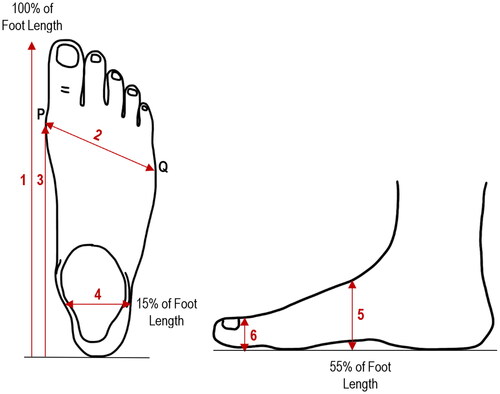
Table 2. The six foot measurements derived from the MATLAB code and the corresponding definitions used as input variables for the cluster analysis (adapted from Kirk et al. Citation2023b, Mickle et al. Citation2010; Wunderlich and Cavanagh Citation2001; Jurca et al. Citation2019).
3. Results
The cluster analysis identified five predefined foot-type clusters based on the foot measurements described above. The silhouette score, which measures how similar a data point is within a cluster compared to other clusters, was 0.3, indicating a fair quality. Of the five measurements imputed, heel width and foot width were the most important predictors of the foot-type clusters, which we named: (i) Extra long-and-wide, (ii) Long-and-wide, (iii) Flat, (iv) Tapered and (v) Short-and-narrow. displays each foot-type cluster’s name, description and representative plantar surface photo. depicts each foot-type cluster’s median and interquartile range for the five foot measurements.
Figure 2. Box and whisker plots of the median and interquartile range for each foot-type cluster for each foot measurement. 1 = Extra long-and-wide, 2 = Long-and-wide, 3 = Flat, 4 = Tapered and 5 = Short-and-narrow.
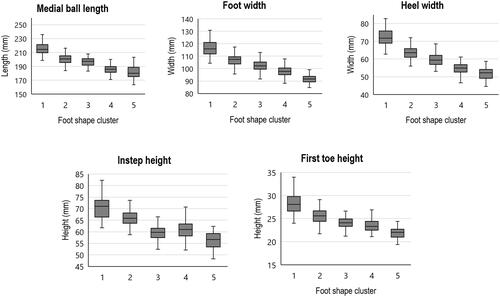
Table 3. The descriptions and plantar surface photos of the five foot type classifications identified using a cluster analysis.
and show the percentage distributions of the five foot types with respect to the participants’ shoe sizes. Participants who wore smaller shoe sizes more often had Short-and-narrow and Tapered feet, whereas those who wore larger shoe sizes tended to have more Extra long-and-wide and Long-and-wide foot types. Players who wore the most common shoe sizes 40 EU and 41 EU primarily had Long-and-wide, Flat and Tapered foot types. displays the distribution of each cluster group based on sex. There was a significant effect of sex on the foot-type cluster (x2 = 230.4, p < 0.001), whereby female netball players were more likely to have Tapered (x2 = 71.69, p < 0.001) and Short-and-narrow (x2 = 72.04, p < 0.001) foot types compared to men. Moreover, men were more likely to have Extra long-and-wide (x2 = 35.7, p < 0.001) and Long-and-wide (x2 = 116, p < 0.001) foot types compared to their female counterparts.
Figure 3. Distribution of the foot-type clusters across shoe sizes for female netball players (EU sizing).
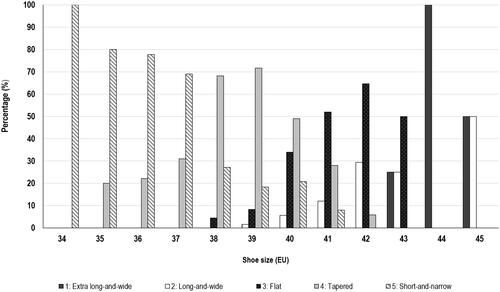
4. Discussion
Athletic footwear must be based on the foot dimensions and foot type of the athletes likely to wear them to ensure the shoes fit and function properly. Although previous research has revealed that male and female netball players have different foot dimensions (Kirk et al. Citation2023b), no research has investigated the foot types of netball players, especially men, to inform recommendations for shoe last designs and size grading systems. This study is the first published research to systemically classify the foot types of male and female netball players. We identified the characteristics of five different foot types within the study cohort: (i) Extra long-and-wide, (ii) Long-and-wide, (iii) Flat, (iv) Tapered, and (v) Short-and-narrow. These foot type clusters provide a more comprehensive understanding of netball players’ foot morphology to improve the fit and functionality of netball shoes. The effect of sex on the foot type clusters and implications for future netball-specific shoe design, especially for male players, are discussed below.
Foot proportions change according to size (Mochimaru, Kouchi, and Dohi Citation2000), a biological mechanism known as allometry (Krauss et al. Citation2008). Allometry is evident in our study, with foot length increase being associated with relative increases in width and height dimensions. For example, Clusters 1 and 2 (Extra long-and-wide and Long-and-wide feet) were predominantly represented by larger shoe sizes. In contrast, Clusters 3, 4 and 5 (Flat, Tapered and Short-and-narrow) were more frequent in smaller shoe sizes. Our clusters were similar to those reported in previous studies that classified the foot types of adults and children (Hong et al. Citation2011; Krauss et al. Citation2008, Citation2010, Citation2011; Mauch et al. Citation2008). For example, Krauss et al. (Citation2008) classified the feet of 795 European men and women into three foot types: (i) a voluminous foot type with large values for arch height, heel width and ball width; (ii) a flat and pointed foot type characterised by a low arch height, long ball of foot length, large ball angle and small heel width, and (iii) a slender foot type characterised by narrow ball width and heel width. Similarly, Hong et al. (Citation2011) classified the feet of 2,321 Chinese men (n = 1,236) and women (n = 1,085) into voluminous, flat-and-pointed, and slender clusters. The results of our study support the results of Krauss et al. (Citation2008) and Hong et al. (Citation2011), which suggest different foot length sizes have different foot type distributions. In contrast to our findings, however, Krauss et al. (Citation2008) and Hong et al. (Citation2011) reported that the voluminous foot type was more frequent in smaller sizes, whereas flat and pointed and slender were more frequent in larger sizes. This difference may be partly due to the greater variability of foot types and clusters demonstrated in netball players compared to these other cohorts (Hong et al. Citation2011; Krauss et al. Citation2008).
Foot allometry is sex-dependent, whereby foot proportions within the same foot length differ for men and women (Krauss et al. Citation2008). In our study, when comparing the absolute foot dimensions of men and women for the same shoe size (40 EU), men had more Extra long-and-wide (male: 5.1% vs. female: 0%) and Long-and-wide feet (male: 26.5% vs. female: 5.7%), whereas women had more Tapered (male: 18.4% vs. female: 49%) and Short-and-narrow feet (male: 0% vs. female: 20.8%). However, for Clusters 1, 2 and 3, when shoe size increased to 43 EU and over, the distribution of foot types changed in men and women. That is, in shoe sizes 43 EU and over, clusters 1, 2 and 3 were more comparable between the sexes, and we did not find noticeable differences in foot measurements between men and women. These results are consistent with the findings of Hong et al. (Citation2011), which suggested that when foot size increased to Mondopoint 250 (universal sizing system), the distributions of their three clusters were comparable between men and women. Based on these findings, we propose that using a women’s netball-specific shoe last is inappropriate for designing a male netball-specific shoe, especially for shoe sizes smaller than 43 EU. A female netball-specific shoe is likely too narrow and not high enough for most males at the instep and toe box. This is also illustrated in , which shows the large variability in the instep and first toe heights between the five foot type groups. Although foot type is more comparable between sexes above the size 43 EU, we suggest that multiple sex and size-related foot dimensions, such as foot height (particularly at the instep) and width measures, be considered during the grading process of netball-specific footwear to accommodate the range of foot morphologies described in this study. This may include offering a greater range of shoes with different midsole/arch and toe box heights to accommodate a greater variety of foot dimensions.
The current practice of grading footwear typically uses a constant increase in height or proportionate scaling according to foot length. However, research has shown foot height is, in fact, unrelated to foot length (Xiong et al. Citation2009), making this practice questionable. The grading of a shoe last should replicate the grading of feet whereby all foot dimensions change systematically with each change in shoe size and reflect interindividual differences in foot shape or size and sex-specific allometric changes in foot measurements (Krauss et al. Citation2010). Given our findings, we recommend that when grading netball-specific footwear, manufacturers should adjust the last considering width measures of the forefoot and rearfoot, and toe and instep height, and how these measurements vary between men and women. The practicability of this procedure has already been demonstrated for children’s shoes (Mauch et al. Citation2008). We also suggest that other methods build on these findings, such as three-dimensional shape modelling that transforms a foot model into a last model using the distortion of control lattice points (Luximon and Luximon Citation2013). These strategies can help manufacturers better understand the last designs and grading system required for netball-specific footwear, particularly for men, who are currently restricted to only one netball-specific shoe that is based on a female last.
As technologies such as artificial intelligence and three-dimensional printing advance, mass customisation could likely become a viable strategy to produce netball-specific footwear to cater for the range of foot types in netball and ensure optimal fit, comfort and functionality. Mass customisation recognises each customer individually and provides tailor-made features for custom fit (Wang and Tseng Citation2013). Custom fit creates a unique last for an individual using the foot dimensions and morphological data of the consumer’s foot and produces a shoe around the custom last (Wang and Tseng Citation2013). This notion is becoming more viable, whereby manufacturers can use three-dimensional foot scanning technology to capture precise measurements of a player’s feet and then print custom footwear to match the specific contours of each player’s feet. Alternatively, a best-matched fit approach can be used, which involves choosing a best-matching last for an individual’s foot (Wang and Tseng Citation2013). Different from custom fit, the last and all shoe components are predefined after measuring a customer’s foot dimensions, and the system selects the last closest to the customer’s measurements (Wang and Tseng Citation2013). This predefined library is generally more extensive than the standard sizing assortment and allows customers to select a different size for the left and right foot (Piller et al. Citation2013). Despite such a system not allowing the "perfect" fit for all possible foot types, it is "good enough" to present a substantial improvement compared to standard sizes available in a regular retail outlet (Piller et al. Citation2013). Given the sex differences and variability in foot types in netball players, we recommend that manufacturers consider custom fit or best-matched fit methods to ensure netball players can identify netball-specific shoes that are likely to fit and function best for their needs. These strategies could begin at an elite level, whereby national-level netball players (i.e., the women’s Australian Diamonds and men’s Australian Kelpies teams) could undergo a fit assessment using three-dimensional scanning during their pre-season. Based on these data, their health professionals could then recommend the correct netball-specific shoe model to suit their foot type and ensure netball players are making informed decisions regarding their shoes worn for netball. Similarly, this research has practical implications for the broader footwear industry where sex-specific problems also exist such as safety footwear.
4.1. Limitations
This study aimed to examine the effect of sex on foot type classifications of netball players. Future studies within this topic should be intersectional by considering other factors, such as body mass index and race, that can influence foot type classifications (Mauch et al. Citation2008; Lee and Wang Citation2015). We also acknowledge that the five foot dimensions used in this study may not fully represent the three-dimensional foot shape of male and female netball players. Future studies should, therefore, build on the present study to classify the foot shape of netball players.
5. Conclusion
Given the sex differences between male and female netball players’ feet, researchers and footwear manufacturers must better understand the foot type classifications of these players to develop sex and size-specific lasts to improve netball-specific shoes, particularly for men. This study revealed the characteristics of five foot type clusters: Extra long-and-wide, Long-and-wide, Flat, Tapered and Short-and-narrow, demonstrating the wide variety of foot shapes in netball players. The results showed that the feet of players who wore smaller shoe sizes were often Narrow and Tapered, whereas the feet of players who wore larger shoe sizes tended to be more Extra long-and-wide and Long-and-wide foot shapes. Nevertheless, there was a significant effect of sex on the foot-type cluster, and the foot proportions within the same foot length differed between sexes. Based on our findings, we recommend developing grading systems incorporating the data of each sex and foot type across various foot length categories. Specifically, the grading of the lasts should be adjusted for width measures of the forefoot and rearfoot and toe and instep height. Manufacturers should also consider custom-fit and best-matched fit methods to accommodate the range of foot types in male and female netball players.
Acknowledgements
The authors thank all participants who volunteered to participate in this study.
Disclosure statement
The authors report there are no competing interests to declare.
Availability of data and material
All data generated or analysed during this study are included in this published article.
References
- Adrian, K. C. 1991. Amercian Last Making: Procedures, Scale Comparisons, Sizing and Grading Information, Basic Shell Layout, Bottom Equipment Standards. Arlington, MA: Shoe Trades Publishing.
- Blattner, M. 2003. Fachbuch—Alles Über Schuhe. Rapperswil, Switzerland: Cityprint AG.
- Cheskin, M. 1987. “Sizing Up Footwear: Here’s a Comprehensive Review of Shoe Types and Proper Fitting,” vol. 8.
- Fox, A., M. Spittle, L. Otago, and N. Saunders. 2013. “Activity Profiles of the Australian Female Netball Team Players during International Competition: implications for Training Practice.” Journal of Sports Sciences 31 (14): 1588–1595. doi:10.1080/02640414.2013.792943. 23672529.
- Hair, J. F. 1998. Multivariate Data Analysis. Prentice Hall.
- Hong, Y., L. Wang, DQ. Xu, and JX. Li. 2011. “Gender Differences in Foot Shape: A Study of Chinese Young Adults.” Sports Biomechanics 10 (2): 85–97. doi:10.1080/14763141.2011.569567.
- Joneja., A, and F. Sai Kit. 2013. "Computer-Aided Design of Footwear". In The Science of Footwear, 213–261. Boca Raton: CRC Press.
- Jung, S., S. Lee, J. Boo, and P. Jaemin. 2001. “A Classification of Foot Types for Designing Footwear of the Korean Elderly.” In 5th Biennial Footwear Biomechanics Symposium, Zurich, Switzerland, pp. 48–9.
- Jurca, A., J. Žabkar, and S. Džeroski. 2019. “Analysis of 1.2 Million Foot Scans from North America, Europe and Asia.” Scientific Reports, 9(1). doi:10.1038/s41598-01955432-z.
- Kirk, M. M., J. P. M. Mattock, C. E. Coltman, and J. R. Steele. 2023a. “Are Male Netball Players Satisfied with the Shoes That They Wear for Netball?” Footwear Science 15 (1): 35–42. doi:10.1080/19424280.2022.2164623.
- Kirk, M. M., J. A. Dobson, J. P. M. Mattock, C. E. Coltman, and J. R. Steele. 2023b. “Do the Feet of Male and Female Netball Players Differ in Shape? Implications for Shoe Design.” Journal of Sports Sciences. Advance online publication.
- Kirk, M. M., J. P. M. Mattock, C. E. Coltman, and J. R. Steele. 2022. “Do the Footwear Profiles and Foot-Related Problems Reported by Netball Players Differ between Males and Females?” Sports Medicine - Open 8 (1): 103. doi:10.1186/s40798-022-00495-y.
- Krauss, I., S. Grau, M. Mauch, C. Maiwald, and T. Horstmann. 2008. “Sex-Related Differences in Foot Shape.” Ergonomics 51 (11): 1693–1709. doi:10.1080/00140130802376026.
- Krauss, I., C. Langbein, T. Horstmann, and S. Grau. 2011. “Sex-Related Differences in Foot Shape of Adult Caucasians - A Follow-up Study Focusing on Long and Short Feet.” Ergonomics 54 (3): 294–300. doi:10.1080/00140139.2010.547605.
- Krauss, I., G. Valiant, T. Horstmann, and S. Grau. 2010. “Comparison of Female Foot Morphology and Last Design in Athletic Footwear-Are Men’s Lasts Appropriate for Women?” Research in Sports Medicine (Print) 18 (2): 140–156. doi:10.1080/15438621003627216.
- Lee, Y. C., and M. J. Wang. 2015. “Taiwanese Adult Foot Shape Classification Using 3D Scanning Data.” Ergonomics 58 (3): 513–523. doi:10.1080/00140139.2014.974683.
- Luximon, A., and Y. Luximon. 2013. “Shoe-Last Design and Development.” In The Science of Footwear, edited by R. S. Goonetilleke, 193–212. Boca Raton: CRC Press.
- Marfell-Jones, M. J., A. D. Stewart, and J. H. De Ridder. 2012. International Standards for Anthropometric Assessment. The International Society for the Advancement of Kinanthropometry.
- Mauch, M., S. Grau, I. Krauss, C. Maiwald, and T. Horstmann. 2008. “Foot Morphology of Normal, Underweight and Overweight Children.” International Journal of Obesity. 32 (7): 1068–1075. doi:10.1038/ijo.2008.52.
- Mickle, K. J., B. J. Munro, S. R. Lord, H. B. Menz. and J. R. Steele. 2010. “Foot Shape of Older People: implications for Shoe Design.” Footwear Science 2 (3): 131–139. doi:10.1080/19424280.2010.487053.
- Mochimaru, M., M. Kouchi, and M. Dohi. 2000. “Analysis of 3-D Human Foot Forms Using the Free Form Deformation Method and Its Application in Grading Shoe Lasts.” Ergonomics 43 (9): 1301–1313. doi:10.1080/001401300421752.
- Netball Australia. 2023. “What is Netball?”. Accessed 25 February 2024. https://netball.com.au/what-netball
- Piller, F., E. Lindgens and F. Steiner. 2013. “Strategic capabilities to implement mass customization of athletic footwear. The example of Miadidas”. In The Science of Footwear, 643–662. Boca Raton: CRC Press.
- Wang, C., and MM. Tseng. 2013. “Mass Customisation and Footwear.” In The Science of Footwear, edited by R. S. Goonetilleke, 625–642. Boca Raton: CRC Press.
- World Netball. 2021. “Inside World Netball 2023.” Accessed 1 June 2023. https://netball.sport/inside-wn.
- Wunderlich, RE., and PR. Cavanagh. 2001. “Gender Differences in Adult Foot Shape: Implications for Shoe Design.” Medicine and Science in Sports and Exercise 33 (4): 605–611. doi:10.1097/00005768-200104000-00015.
- Xiong, S., RS. Goonetilleke, J. Zhao, W. Li, and CP. Witana. 2009. “Foot Deformations under Different Load-Bearing Conditions and Their Relationships to Stature and Body Weight.” Anthropological Science 117 (2): 77–88. doi:10.1537/ase.070915.

